While one of the Slovak education system’s strengths is the high value placed on teaching the country’s language and culture, a more student-focused, project-based learning model provides students with broader real-life experience, says Aaron King, Director of the Cambridge International School in Bratislava.
“Project-based learning gives students the opportunity to connect what they have learnt in different subjects,” he explains. “It gives them opportunities to develop really valuable independent and collaborative research, planning, critical, reflective, and public showcase skills.”
The Slovak Spectator spoke with King about the differences between the education systems in Slovakia, China and the UK, and about project-based learning, his school’s curriculum, and whether there is any such thing as a ‘typical’ student at his school.
You have worked in education in Great Britain and in China. How do those education systems differ from Slovakia’s?
One of the key differences that I see in Slovakia is the extent to which the educational model is developing. Both in the UK and in China, while the educational models are quite different, they are more or less fixed. Slovakia is moving towards significant growth, experimenting with different styles of education and is open to new ideas and approaches.
In China in particular, there remains a major fixation on examination results, preparing for tests and teacher-centred approaches where the teacher is very much the fountain of knowledge, passing that knowledge down to children. The UK model has become over many years much more child-centred, focused on children discovering what their individual skills and talents are, and inquiry-based approaches to learning and project-based learning are much more common. We are seeing a real appetite for this in Slovakia.
What are the pros and cons of the education system in Slovakia?
One of the strengths of the system is that Slovak language and Slovak culture is still very much valued. In comparison, the British system has become very global, perhaps too much so. For example, children don’t necessarily learn all that much about British history, British culture and British geography. They explore a lot of topics at a very global level, which I see as very important of course because we live in an international world. However, I think you need to have a strong base. When I compare the Slovak system to Chinese education, China’s is perhaps too focused on China, the Chinese language and Chinese culture, so there has to be a balance.
I think Slovakia is getting it right and this is the emphasis in our school, too. We want our children to develop very strong English, but all our children, whether they are Slovak or non-Slovak, learn the language, learn about Slovak culture and embrace the society in which they live. That’s very important. If we want children to learn more about the world out there, they need to start by understanding the world and the society around them.
What priority does teaching the Slovak language have at your school?
While the majority of our learning takes place in English, all the children learn Slovak, either as a first language with literature or as Slovak for foreigners, which we prefer to call Slovak as an additional language. We are an international school which produces students with very high levels of English, but we are also attached very closely to Slovak culture and the community.
In China, one of the schools that I worked in was almost too international and very much in a bubble disconnected from the society and the world around it. I believe that many foreign parents want their children to build meaningful relationships here, show great respect for their adopted homeland, even if they are here for just a few years, and to learn about the culture of which they are part – it will serve them well as global citizens in the future, wherever they end up.
How would you describe a typical student at your school?
There’s no typical student, they’re all very individual. We value good manners, good behaviour, effort and progress, inside and outside the classroom, but we want our students to be themselves and to be the best version of themselves – above all, happy coming to school and developing in their understanding of themselves and personal goals for the future.
In terms of nationalities, about 70 percent of our students are Slovak with one or both parents Slovak, but often having spent some time abroad. Our students are predominantly European, though we do have pupils from many other parts of the world. We have some children from Korea, from the United States, from India, and from Brazil, for example.
How many students do you have?
We are a medium-sized school split into different sections. We have over 500 students in the primary and secondary schools at present, and we also have at least 250 children in our four ‘Funiversity’ kindergartens.
Being a medium-sized school is ideal because children can find their identity in the school, but also feel that they are part of a community. If a school is too small, it’s difficult for a child to have a very meaningful community experience or have access to the very best resources, and if a school is too large, a child can feel lost.
What is the difference between the way students are taught in state schools in Slovakia and at the Cambridge International School?
There are a number of differences. One of them is in the relationship between the teacher and the students. The teacher training system for teachers in Slovakia is still quite traditional in terms of teachers learning their subject, not necessarily learning how to work best with young people. At our school, we want teachers who we see as learning facilitators, who are well qualified and who know their subject well of course, but who above all like working with children and who are really able to inspire young people. The focus is on building a relationship with them and encouraging them to take responsibility for their own learning.
Another main difference is that we do not focus on textbook-learning. Textbooks are out of date the minute they’re printed. Some of the textbooks that are still in use in Slovakia are textbooks that probably are not very different from those that the students’ parents had when they were at school. It’s good to have continuity in the educational system, but one of the key questions that I encourage students to ask is ‘Why are we learning this and what is the value of learning this?’. Educators need to have a meaningful and compelling response and the answer can’t just be ‘because this is what we’ve always learnt’. Learning has to have value today. So, for example, if we look at literature it’s still important to study classic Slovak or English literature, but the teacher has to present it so that it has meaning for children today, in their context, and is exciting for their time.
How much freedom does your school have within the Slovak education system to create its own curricula?
We are a private independent school subject to the regulations of the Slovak Education Ministry. We’re very compliant when it comes to ensuring that we are providing the set numbers of learning hours across the curriculum in the various different subjects, reporting as we are required, and preparing our students for regular testing, such as Testovanie 5 and Testovanie 9. Our students can also choose to do the Slovak leaving exam - maturita - if they wish to. All our students do IGCSE and A-level leaving exams in the four years of Upper Secondary, which is what we call our high school programme. When it comes to implementation of the curriculum however, we have quite a lot of freedom.
In terms of curriculum, we follow a curriculum designed by Cambridge Assessment International Education which is a department of the University of Cambridge in the UK. As such, we’re a Cambridge school offering the Cambridge International curriculum. It is based to some extent on the English national curriculum, but is much more suitable for a non-British audience. What we also try to do is to deliver that curriculum in a Slovak context and with Slovak examples and comparisons where possible. In this sense our students are being offered a Slovak education to an extent, but not in the same way as at a state school.
Cambridge schools provide the same or a similar curriculum and identical international qualifications, but they are not connected as such. We are very much an independent school in that respect. However, when our students sit formal IGCSE and A-level examinations, children at Cambridge schools all around the world are sitting exams for the same qualification with the same examinations. The grades that they are awarded are of the same level. This sets an international gold standard so that the qualifications students get can be understood by universities and hopefully future employers all around the world.
We are very proud of our 100% university acceptance rate and for the flexibility which our programmes allow. Students can study in Europe, the UK, the USA, Australia, Canada, Korea or even in Slovakia with our school qualifications. Many attend top 50 global universities, but for us it is more about the right fit than ranking. Will this young person be fulfilled, be pursuing their dreams, will they be happy in this university and location, will they succeed and will this choice work for their family too? If the answer is “Yes!” then we have really fulfilled our role as educators and facilitators.
Your school has introduced project-based learning into its curriculum. Could you explain what project-based learning is and its benefits?
Project-based learning (PBL) is a pretty unique style of learning. The big difference between PBL and traditional teaching is that PBL is very student-focused and mirrors real life – it is highly relevant for young people growing up in the 21st century.
Rather than students going from one lesson in one subject to another that is entirely disconnected, one of the principles of PBL is that it is focused on a thematic curriculum. So what students learn in Maths, History, English, Slovak or Science can all be brought together into some kind of overall project with a specific outcome that is student-led. The showcase might be a student standing up in front of their class doing a presentation, it might be them completing an essay, making a video or podcast, or creating an object or artefact. It might even be them doing an act of service in the community or planning and organising an event. This way of learning gives the students opportunities to explore beyond the boundaries of the curriculum and to connect their knowledge from different subjects. It gives them opportunities to develop research, planning and reflective skills.
It also has to be authentic, so the students themselves see the value and are interested in researching further. It also needs to have relevance for their lives and reflect their local realities.
Do students work in groups on particular projects within PBL?
Sometimes they work individually, sometimes they work in pairs. or in groups, or even as a whole class. There are different ways to do PBL to get different outcomes. This is because part of it is about working in a team but also taking individual responsibility.
In terms of topics, the projects focus on answering big questions, however, in a manner appropriate for their age.
Could you give an example of such a project?
We try to get the young people to think outside the box. For example, I myself teach Year 9 students and our last project was ‘What is progress and is it always good?’. The students had to consider the concept of progress, whether it was in terms of human rights, architectural development or changes in sport, and to come up with their own answer as to whether these were good or not. Their new topic is about how to close the generation gap. The outcome might be a pamphlet helping older people learn how to use TikTok or Facebook.
Are schools in Slovakia prepared to embrace project-based learning?
Developing the right model for the context takes time, of course. Slovakia’s education system is transitioning in a positive direction, but perhaps schools are not ready yet for a fully-immersive programme of project-based learning which would require a whole rethink of the curriculum and timetable, a very different approach to teacher training and a deeper understanding of the benefits of an approach which is still very new to most parents and even educators.
I am also not entirely certain that a fully immersive PBL approach, with no structured lessons and no formal examinations, is ultimately the right model. The model at CIS is an embedded PBL model in which we use a thematic curriculum, discrete PBL lesson time, dedicated whole school Project Weeks and extended passion projects and essays for Upper Secondary students in order to deliver PBL. I believe that this, along with the Cambridge curriculum, provides the best of both approaches to learning.
Who are the teachers at your school?
We are a modern European international school and so it is important that students hear different voices, both in terms of different perspectives but also, literally, different voices! That helps them to have a better understanding of the world and to appreciate different perspectives for their own lives ahead, which are likely to be international to some extent at least.
We try to have as much diversity and inclusion as possible among the staff. We have a lot of Slovak staff and Slovak teachers but also teachers from lots of different countries. We have, of course, English teachers who are first-language English speakers and Slovak teachers teaching Slovak as a first language. In Spanish and German, we like to have a blend there of both first-language speakers and also Slovak teachers who have mastered a third language, as adult role models are very important in developing the next generation.
Have you encountered any problems with hiring new teachers, given that there is a shortage of teachers in Bratislava?
Yes, to an extent, but I am still delighted with the quality of staff which we attract and retain. Finding the right teachers for our school is not always easy, in part because we are so selective in terms of what we are looking for.
Along with this, challenges related to Brexit and Slovak employment regulations for third country nationals have certainly not made international recruitment easy and we are also looking for staff who have PBL experience, a growth mindset towards education and a genuine desire to live and work in Slovakia.
So, it’s not always easy, but I think people are inspired by what we’re trying to do here. Our children want to learn, they work hard and are enthusiastic about learning, so we attract top talent.
Do you have any financial-support scheme for gifted children?
We do not have a formal support scheme throughout the school, although we do offer potential opportunities for new students entering our Upper Secondary in our Year 10 (Year 9 in the Slovak system) As a fee-paying school, we also try to keep our fees at an affordable rate to cover all our costs and very competitive compared to others. If a student’s parents are in financial difficulties, we are always willing to consider what we can do in terms of support, as it’s important that children’s education is not disrupted where there are potential compromises which can solve short-term difficulties.
When the Ukraine crisis began, we also provided facilities here after school for the Ukrainian School in Evacuation in Bratislava (Ukrajinská škola v evakuácii), so the students could continue their Ukrainian education. It’s a great feeling to partner with them and be able to help, because education is about giving back, making the world a better place and preparing future generations for positive change.
How are your school’s relations with other international schools in Bratislava?
We have very good relationships. This is because we are not direct competitors as such as each of us offers something quite different. We often face the same issues too, for example as we did during the Covid pandemic, so there is good communication among a number of schools.



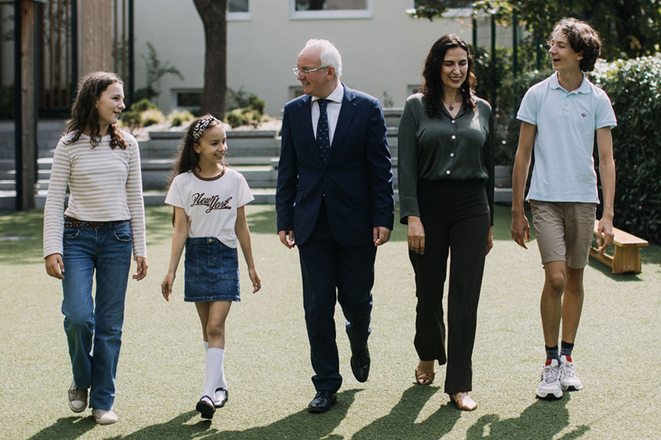 Aaron King in the grounds of the Cambridge International School in Bratislava with his family, wife Loredana, son Octavian and daughters Annabelle and Alexandra. (source: Courtesy of CIS)
Aaron King in the grounds of the Cambridge International School in Bratislava with his family, wife Loredana, son Octavian and daughters Annabelle and Alexandra. (source: Courtesy of CIS)
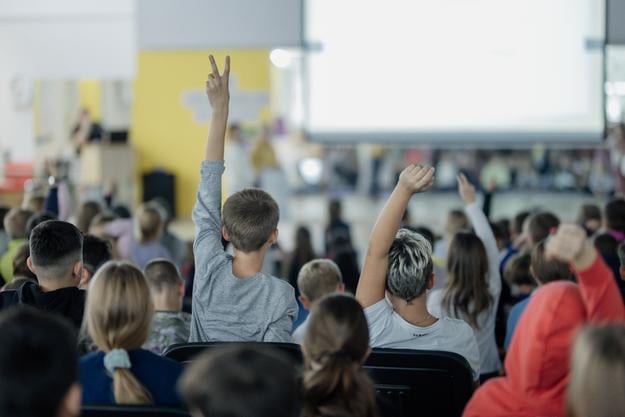 (source: Courtesy of CIS)
(source: Courtesy of CIS)
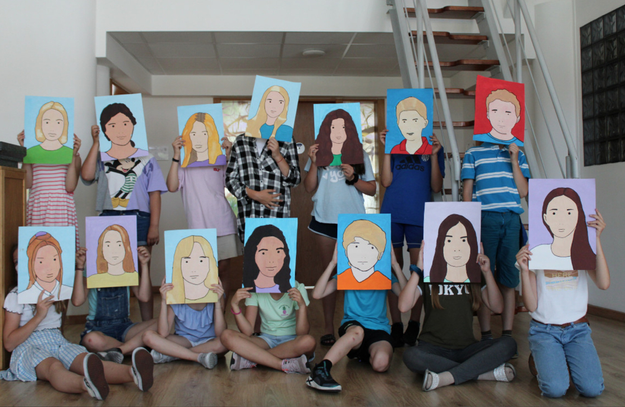 (source: Courtesy of CIS)
(source: Courtesy of CIS)
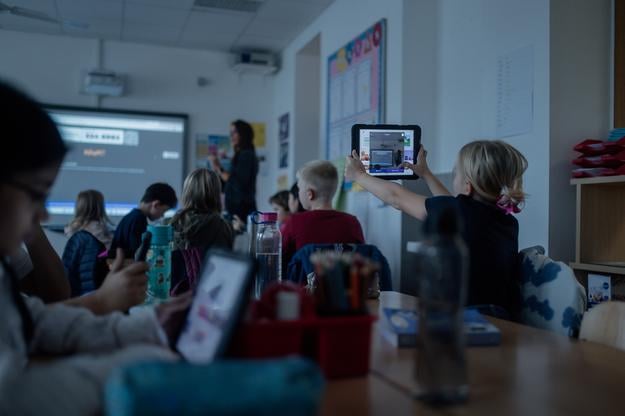 (source: Courtesy of CIS)
(source: Courtesy of CIS)
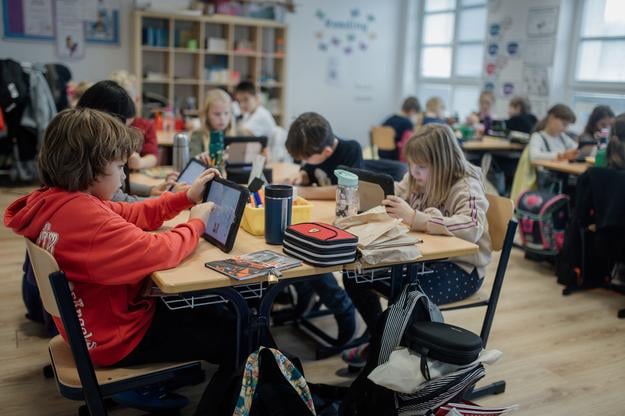 (source: Courtesy of CIS)
(source: Courtesy of CIS)